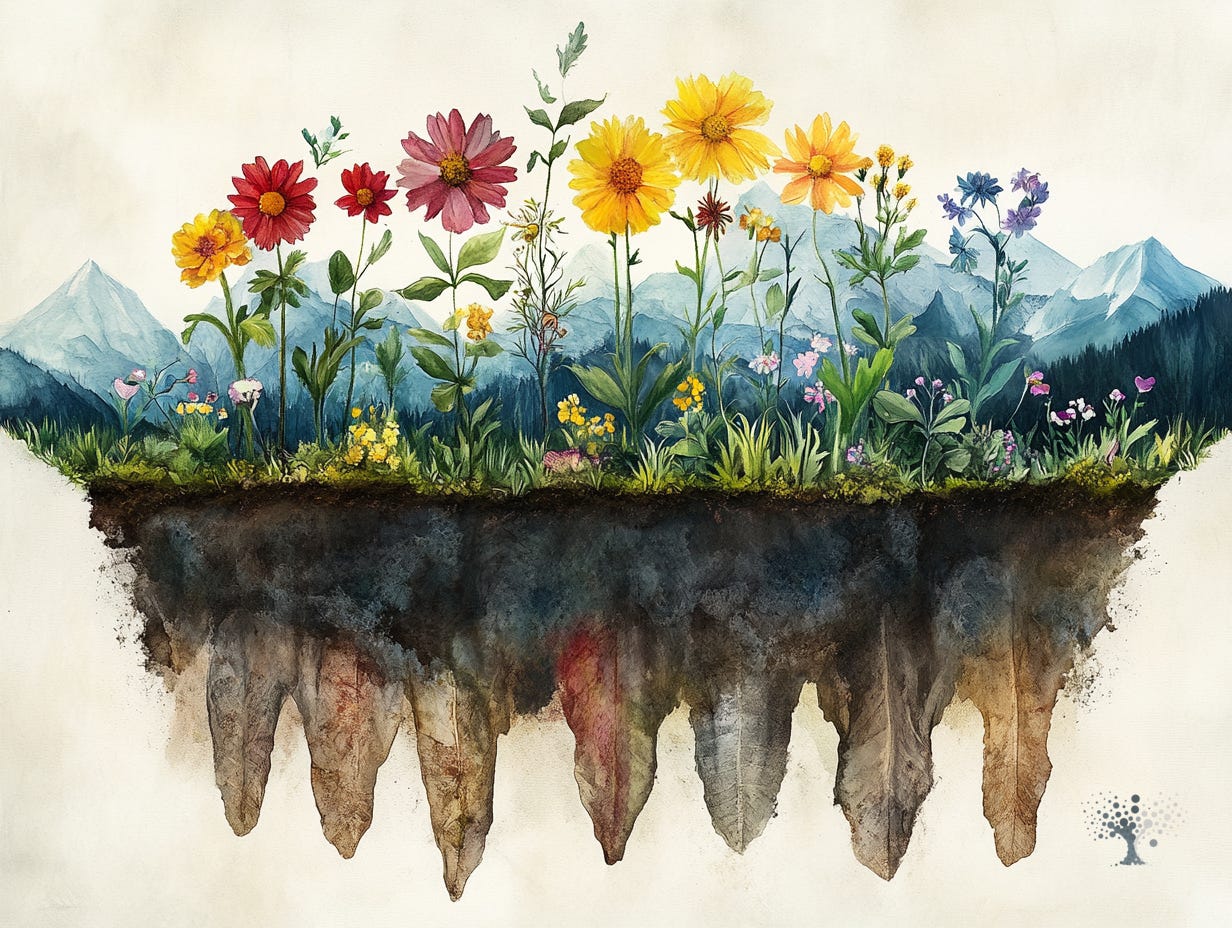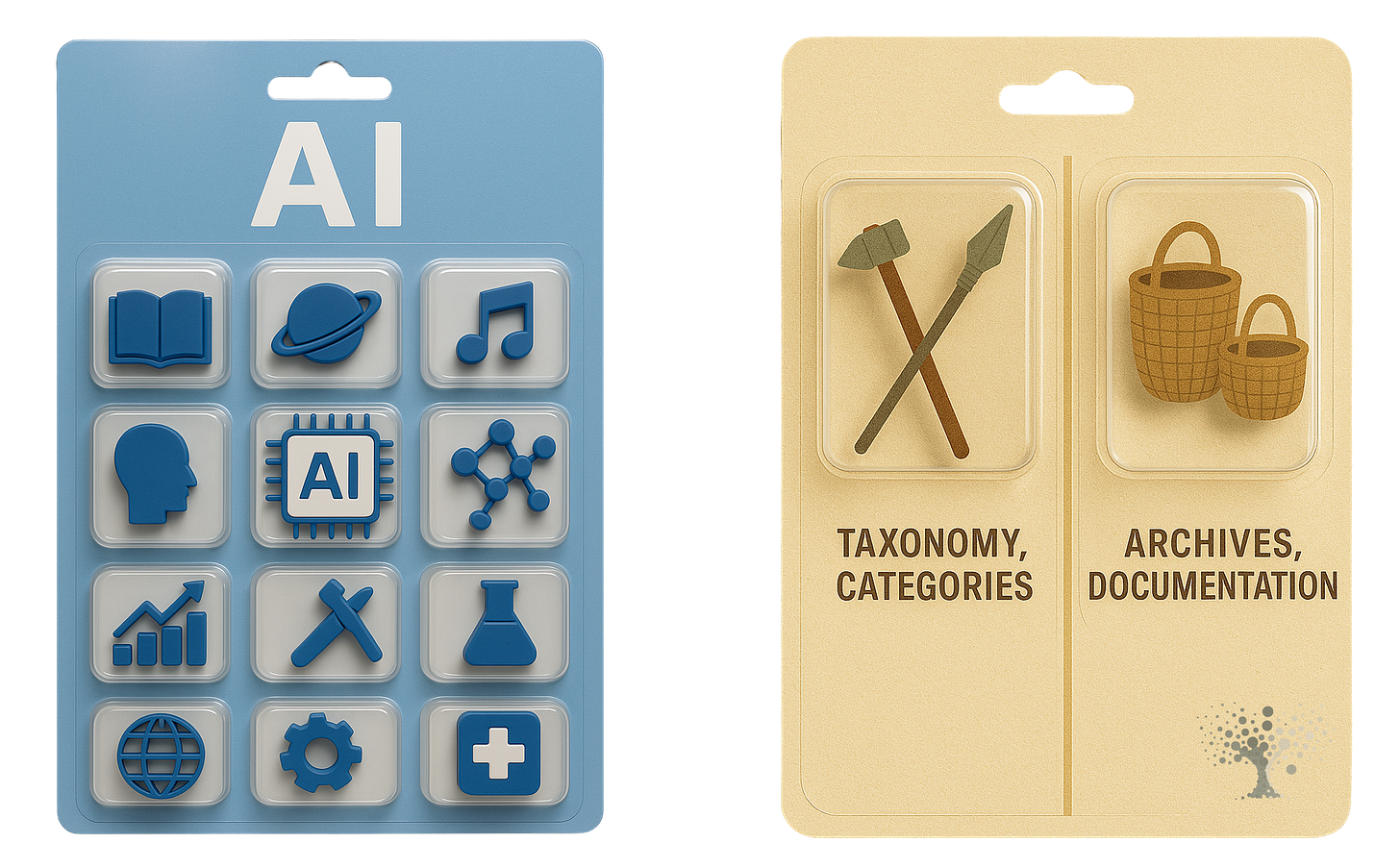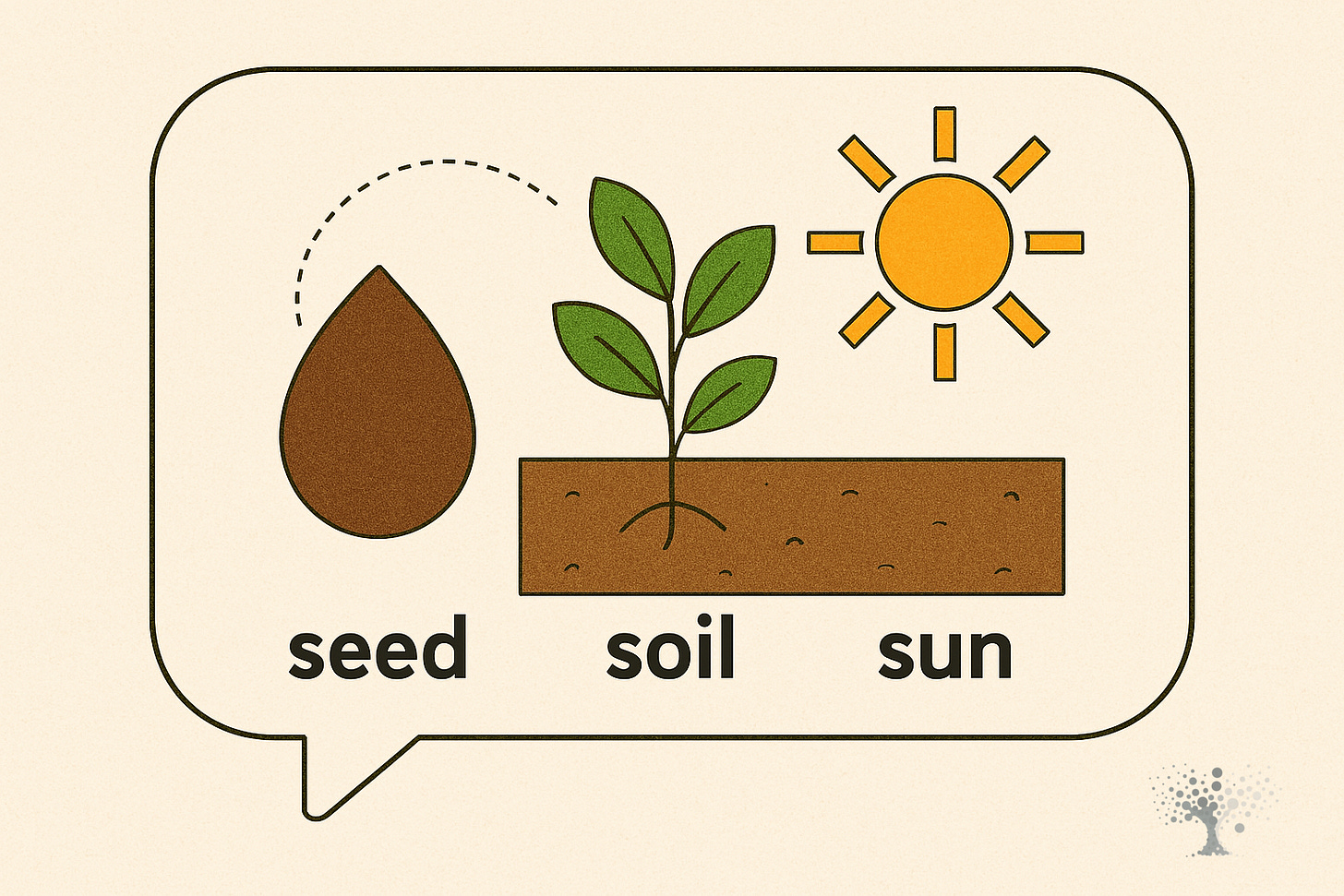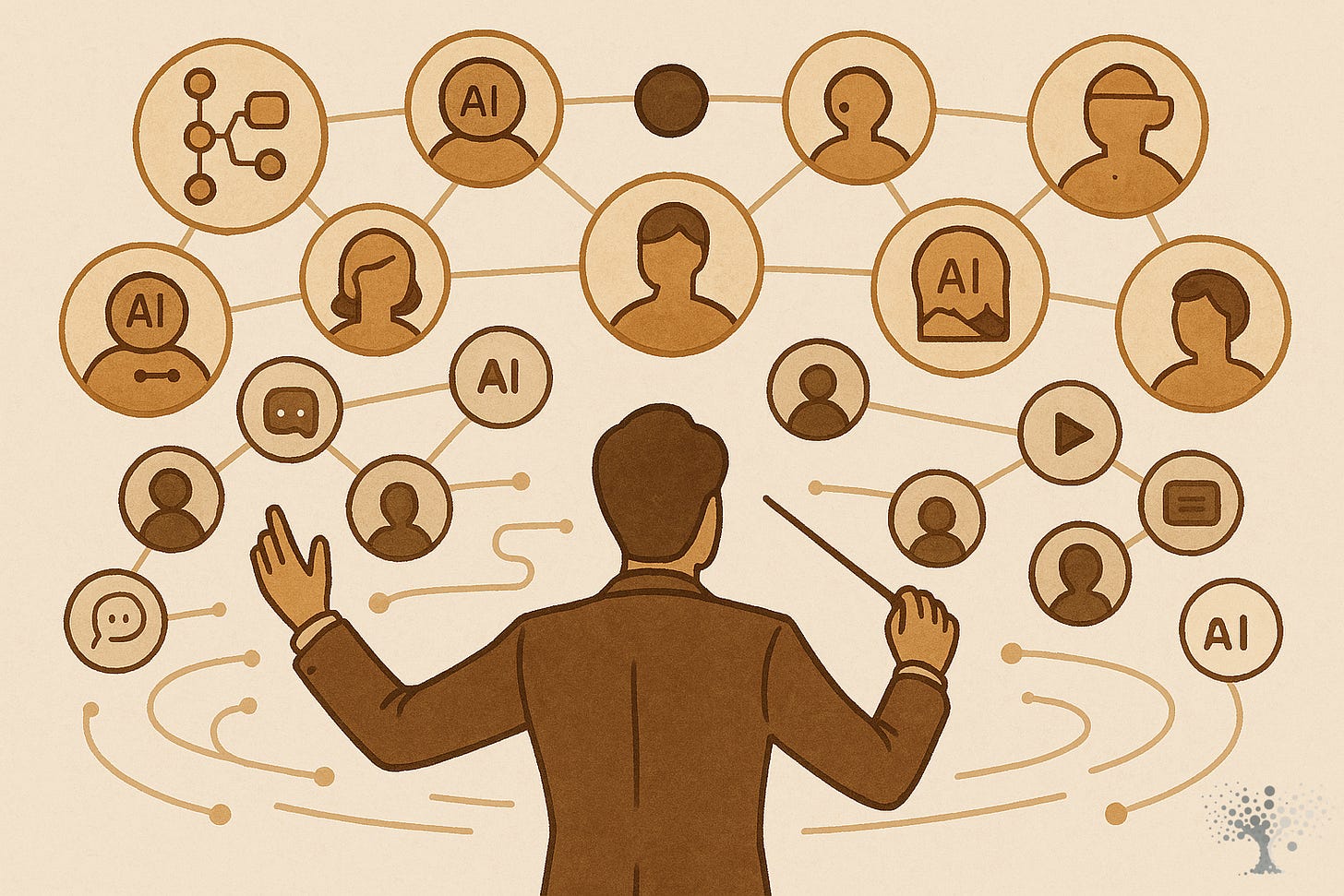The Long Now of Understanding
This section title references Stewart Brand's Long Now Foundation concept of taking a long-term perspective on human civilization and knowledge
Every significant shift in how humans develop knowledge follows a predictable evolutionary progression. We begin with primitive tools that extend our natural capacity for understanding, then develop increasingly sophisticated ways to augment our thinking, until eventually we create symbiotic systems that fundamentally transform how we relate to knowledge itself.
We are now witnessing such a transition in real-time. After a half-century of digital hunting and gathering — with ever-more sophisticated tools for finding, indexing, and retrieving data — we are poised to enter an age of knowledge farming.
Humanity is experiencing its fourth great transition in knowledge evolution—moving from digital hunting (searching and retrieving information) to knowledge farming (cultivating understanding over time).
In the roughly 200,000 years of human existence, we've experienced three great transitions that fundamentally changed our relationship with understanding:
First, language emerged, allowing us to transmit knowledge beyond what could be directly observed. Second, writing evolved, enabling knowledge to persist beyond individual memory. Third, printing arrived, allowing understanding to scale beyond local communities.
Each of these transitions didn't just increase the quantity of accessible information — they qualitatively changed how humans thought.
We're now experiencing the fourth great transition. And as with the others, we won't understand its full implications for generations.
Hunting vs. Farming: A Knowledge Paradigm Shift
Before exploring this transition in depth, let's analyze the historical parallel that frames our discussion. Much as the agricultural revolution fundamentally transformed human civilization, the shift from information hunting to knowledge farming represents a similar paradigm leap.
First, a note on terminology: I deliberately use "knowledge" rather than "information" throughout this analysis. "Information" etymologically derives from "inform" — to give form to something, implying a discrete, time-limited transfer with a single right answer. This framing is intrinsically tied to the hunter-gatherer paradigm. "Knowledge," by contrast, connotes a cumulative, evolving understanding built over time — precisely what the farming paradigm enables.
With that distinction established, let's examine these contrasting paradigms:
Information Hunting & Gathering:
Emphasizes the discovery and collection of existing information
Values speed and efficiency in finding answers
Focuses on retrieval expertise and knowing where to look
Success is measured by what can be found and consumed
Creates temporary value through immediate insights
Knowledge Farming:
Emphasizes the cultivation and growth of understanding over time
Values depth and systemic relationships between ideas
Focuses on creating environments where insights emerge
Success is measured by the sustained growth of knowledge
Creates a persistent value through evolving comprehension
"Knowledge farming" focuses on growing and nurturing insights, emphasizing systemic relationships, depth, and evolving comprehension.
The strategic implications are significant. In the hunting paradigm, the competitive advantage lies in superior search capabilities — finding information faster or more accurately than others. In the farming paradigm, advantage comes from creating more fertile environments for knowledge to grow and interconnect.
This shift isn't just a metaphor—it's a fundamental reorientation of how we relate to information and understanding in the digital age. The remainder of this article explores the implications of this paradigm shift across multiple dimensions.
The Strategic Paradigm Shift
This transition represents what we might call a "paradigm mismatch" in the technology industry, drawing on Thomas Kuhn's influential framework of paradigm shifts in scientific revolutions. Most of today's AI interfaces still follow a hunter-gatherer logic. Consider ChatGPT — despite its revolutionary capabilities, it's essentially a friendlier search interface. A more conversational hunting tool.
This is much like when Microsoft attempted to extend the PC paradigm to mobile, as Ben Thompson has astutely analyzed. The mistake wasn't missing mobile as a category; it was attempting to apply an outdated mental model to a fundamentally new context. Today, we're making the same error by extending hunter-gatherer information models to an AI world where they no longer fit.
The traditional paradigm of information architecture has been built around a "hunting and gathering" mental model: we categorize, organize, search, and retrieve. These approaches served us well in a world where knowledge was scarce, creation was difficult, and organization was our primary challenge.
The transition shifts strategic value from raw information and simple categorization to systems that nurture emergent understanding and insight.
To understand the magnitude of what's happening, we need to examine three fundamental shifts in how information architecture functions in the age of AI:
1. From Finite to Infinite Ontology
Traditional IA models rely on defining:
Ontology: What exists
Taxonomy: How it's organized
Choreography: How it flows
This information architecture framework builds on established information science principles developed by scholars like Peter Morville and Louis Rosenfeld, with choreography extending these concepts to address dynamic information flows as articulated by information theorists.
In an AI world, what "exists" is effectively infinite. Categories multiply continuously. Content is generated on demand. Context shifts by the second.
This is like trying to organize a river — you can label the water, draw borders around it, even name every ripple, but the river keeps moving. Static categories become insufficient in a world of dynamic content.
2. From Organization to Orchestration
When categories and taxonomies can no longer contain the scope of available information, choreography — the orchestration of information over time — takes center stage. This concept of information choreography draws from the work of information flow theorists who focus on dynamic relationships rather than static categories.
Traditional Information Architecture (IA) struggles in AI environments because it relies on static categories, while AI creates dynamic, ever-changing contexts requiring "orchestration" rather than "organization."
This isn't just about smoother workflows. It's about dynamic adaptation across agents, tools, and shifting user intents. The ability to pivot when new information appears, recalibrate when contexts change, and weave together multiple perspectives.
3. From Retrieval to Reflection
The limiting factor is no longer access to information but making meaning from it. This is where the hunting model fails us most significantly — it assumes that finding is the same as understanding.
Real insight requires more than speed and accessibility. It requires:
Time for reflection
Contextual scaffolding that combats blank page syndrome
Systems that support behavioral insight, not just linguistic understanding
Space for parallel inquiry and exploration
The integrity to connect stated preferences with actual behavior
Systematic nurturing across multiple dimensions
Environments where ideas can evolve over time
The Aggregation Theory of Knowledge
In Ben Thompson's Aggregation Theory terms, what we're witnessing is a profound shift in the value chain of knowledge work. AI has commoditized content creation and basic information retrieval, pushing value toward higher-order activities:
Commoditized: Raw information, basic retrieval, simple categorization
Differentiated: Contextual understanding, insight development, decision orchestration
Strategically Valuable: Systems that nurture emergent understanding over time
The winners in this new landscape won't be those who build the fastest hunters, but those who create the most fertile farms — environments where knowledge can grow, insights can emerge, and decisions can evolve with integrity.
The challenge for product leaders and UX professionals isn't just technical implementation but philosophical integration. How do we:
Address blank page syndrome – not with more content, but with contextual scaffolding that invites action and creativity?
Ensure decision integrity – connecting what people say with what they actually do in real-world contexts?
Support parallel inquiry – enabling exploration across multiple dimensions simultaneously, rather than through linear paths?
Incorporate behavioral insight – moving beyond language to understand and respond to real-world actions?
Create interfaces that reveal rather than reinforce biases?
Build processes that optimize for synthesis rather than speed?
Develop frameworks that evolve as understanding deepens?
These questions cannot be answered through traditional design thinking alone. They require what we might call "Knowledge Architecture" — the intentional bridging of theories of knowledge with practical design methodologies.
The Three Elements of Knowledge Farming
Every successful agricultural system balances three fundamental elements. The knowledge farming age will require the same:
1. Seeds (Planting) — The initial questions, hypotheses, and nudges that start the growth process.
Like their biological counterparts, idea seeds contain potential, but many will never germinate. The art is in planting many variations and nurturing those that take root.
2. Soil (Environment) — The semantic and technological substrate in which knowledge grows.
Just as different soils produce different flavors in wine grapes, different frameworks yield different wisdoms from the same initial ideas. Rich conceptual soil provides both structure and nourishment.
3. Sun (Nurture) — The ongoing attention, feedback, and refinement that transforms potential into actuality.
Without care, even perfectly planted seeds in ideal soil will wither. Systematic nurturing — the returning, revisiting, and rethinking — is what metabolizes raw information into genuine knowledge.
The Strategic Path Forward
The strategic implications are clear: companies must shift from building tools that merely assist humans in retrieving information to creating environments where understanding can grow.
This means:
Moving from static sitemaps to living systems that can support parallel inquiry
Evolving from organizing words to orchestrating behavior and ensuring decision integrity
Transitioning from information retrieval to insight cultivation through contextual scaffolding
Building interfaces that address blank page syndrome through structure, not just more content
Creating systems that learn from what people do, not just what they say they want
The companies that master this transition will create fundamentally different relationships with their users — relationships based not on transactions but on transformation, not on content delivery but on cognitive partnership.
The Coming Knowledge Ecosystems
The strategic opportunity is clear: the companies that understand this shift will create fundamentally different relationships with their users.
The dominant digital platforms of the last decades succeeded by organizing the world's information (Google), connecting people (Facebook), or streamlining commerce (Amazon). The dominant platforms of the next decades will succeed by cultivating the world's understanding — creating environments where knowledge can grow over time through the interaction of human and machine intelligence.
The future of digital platforms lies in creating ecosystems where human and machine intelligence evolve symbiotically, emphasizing sustainable and meaningful knowledge growth over rapid information delivery.
This isn't just a new feature set. It's a new kind of digital habitat — one that feels less like a tool and more like a garden.
In these emerging knowledge ecosystems:
Knowledge doesn't just flow; it cycles and recycles
Understanding isn't just retrieved; it's cultivated
Knowledge isn't just queried; it's nurtured
The 10,000-Year View
The transition from hunting to farming transformed humanity's relationship with the natural world. The shift from information retrieval to knowledge cultivation will similarly transform our relationship with understanding itself.
This won't happen overnight. Original agriculture took thousands of years to spread and mature. But knowledge farming will likely evolve much faster, with major shifts visible within decades rather than millennia.
The key question for all of us is whether we recognize this transition early enough to shape its development wisely. Will we create knowledge ecosystems that promote deep understanding, meaningful connection, and sound decision-making? Or will we simply accelerate the production of information without enhancing our capacity to derive meaning from it?
The choice is ours. As with all technological revolutions, the tools themselves are neutral. It's how we design and use them that matters.
The most promising path forward lies in consciously developing knowledge systems that:
Honor the natural rhythms of human cognition
Support the slow growth of understanding over time
Connect insights across seemingly separate domains
Bridge what we think with what we do
If we succeed, we'll create not just better tools but better ways of thinking together — new forms of collective intelligence that help us navigate our increasingly complex world with wisdom, creativity, and care.
The age of information hunting served us well. The age of knowledge farming awaits.
This article is the first installment in the "Designing Intelligence" series, exploring how human and machine intelligence can evolve together through strategic design, stewardship, and thoughtful integration. The ideas presented here were first introduced in a talk I delivered at the Information Architecture Conference in 2025 (IAC25). This is an amazing conference, and if you get a chance, you should go.
Future installments will dive deeper into more grounded examples, detailed practical guidance, and a thorough exploration of the pragmatic and ethical challenges that arise in this transition.
As we continue this series, we'll move from the conceptual frameworks established here to concrete implementation strategies, examining real-world applications across industries and contexts. We'll provide actionable insights for practitioners while addressing the complex ethical considerations that emerge when redesigning our relationship with knowledge at this fundamental level.
Join us as we explore how human and machine intelligence can evolve together through strategic design, stewardship, and thoughtful integration—creating knowledge ecosystems that serve humanity's deepest aspirations rather than just our immediate informational needs.








